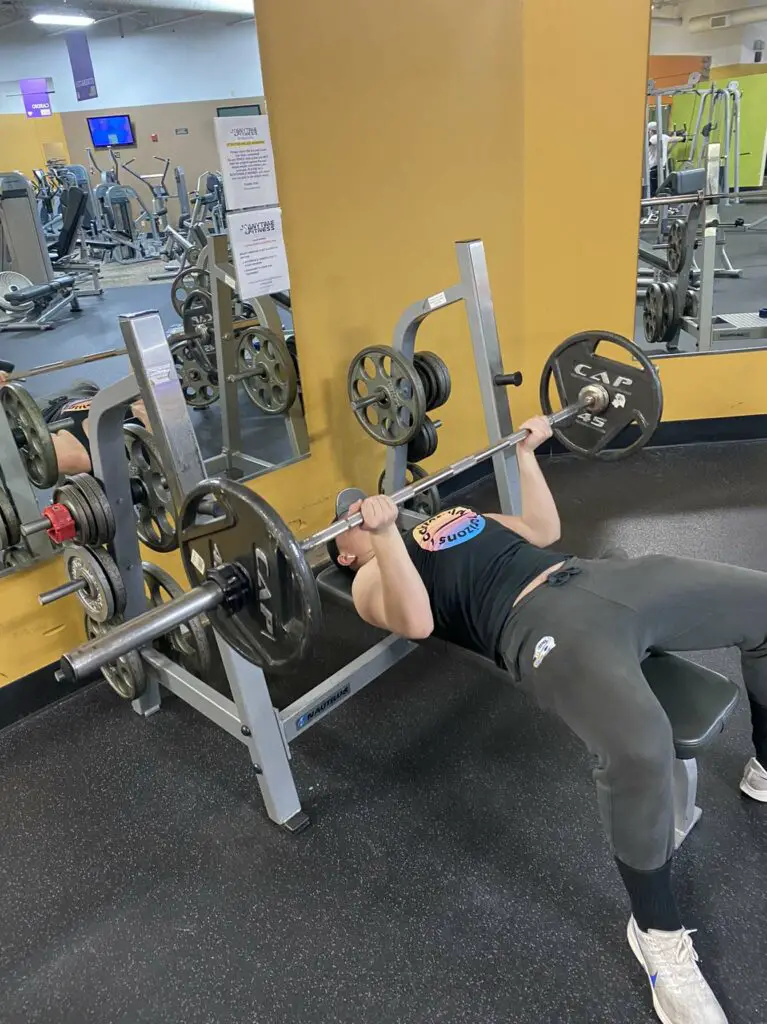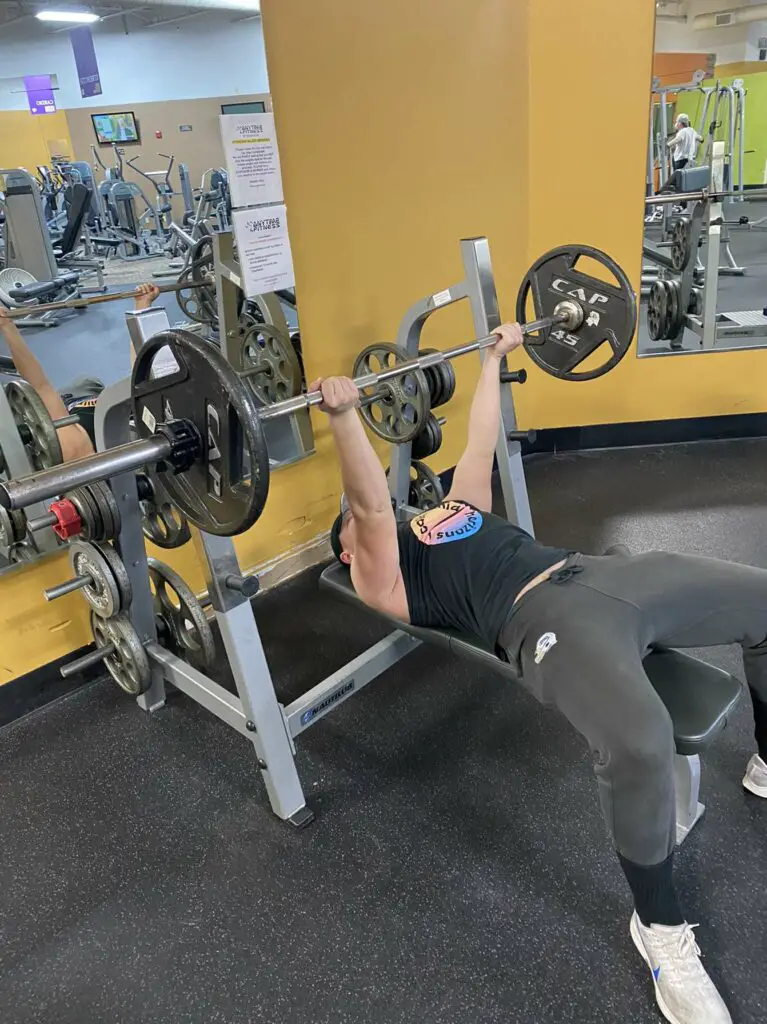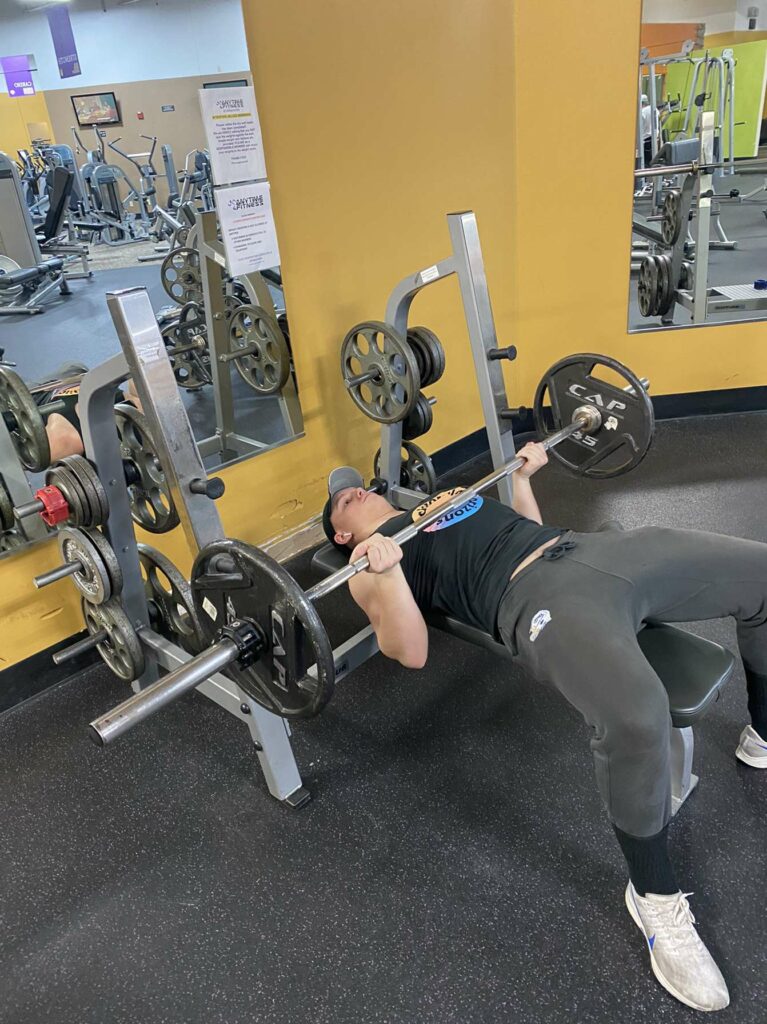Imagine if you could bench press without excessive shoulder pain, still get the same chest growth, and save yourself from potential future injuries? Honestly, it sounds like a dream come true. But, the reverse grip bench press is exactly that.
It’s no secret that the bench press is a dangerous movement. In fact, the military has even stated that while soldiers are deployed, bench pressing seems to be one of the most dangerous movements causing some of the most injuries on base.
- Key Point: Reverse Grip Bench Press is much better on the shoulder joints, with the same chest activation. If you have shoulder problems, this exercise can be your savior!
So, how can we remedy this while still working on our chest muscles? Simple: The reverse grip bench press.
The shoulder joint is far more secure in the reverse grip position and has a way smaller chance of causing severe injury or bodily harm.
And some people even say that they are able to feel the reverse grip bench press more in their pecs and get a better squeeze overall. And a lot of bodybuilding is actually the mind-muscle connection and making the muscle work as hard as it can.
The Canadian Memorial Chiropractic College, Toronto says the Reverse Grip Bench Press can provide 30% more upper pectoralis activation than the normal bench press grip!
- Key Point: This grip just overall gives you better chest growth than a normal bench press.
So, let’s talk about the reverse grip bench press and get you all the information you need to apply this to your next workout and supercharge your physique.

The Dangerous Truth About the Bench Press
Look, I got a big shoulder problem. In fact, my arm will dislocate out of the socket- yes that’s right. Like, literally come out of my shoulder socket. And this problem became 1000x worse whenever I benched with normal grip.
- Is your grip slipping on the bench or in general at the gym? Check out the best weightlifting chalk.
Most notably, after I hit a bench max last week with a normal grip, I almost had to go to the hospital to get my arm fixed as I could barely get it back in on my own. Yes, the pain is just absolutely horrendous. (Your body has a way of telling you that your arm is NOT where it’s supposed to be)
I couldn’t live with it anymore. The normal bench press grip was destroying me. And if you’re on this article, trust me- it’s time to switch. You don’t want to have this.
Look, the standard bench grip puts your shoulders in a very dangerous and vulnerable position. Ever notice that no workout program includes upright rows anymore?
It’s because the upright rows force your shoulders into a very unnatural and destructive position- the same position your shoulders are in on the bench press.
Since the upright rows have been phased out, I think it might be time the bodybuilding community starts getting rid of the standard grip bench press. And, they’ve already kind of started this process.
In fact, powerlifters only have to move the bar to a block on the chest, making the range of motion much shorter to try and reduce shoulder injury.
What is a Reverse Grip Bench Press?
The reverse grip bench press isn’t something too common in the gym. (However, it has seen a big rise in popularity recently.) So, let’s explain what it is.
The reverse grip bench press is like a normal bench press, except you have your grip in ‘reverse’, so your palms would be facing towards you instead of away from you. You know the grip you use when curling a dumbbell or bar? It’s just like that, except on the bench press barbell. Here’s a picture:

At first, it may seem foreign or weird. But you can get used to it super fast and you might even find the grip even better.
All you do is lift the barbell off the rack (although I’d recommend having a spotter help you lift the bar off, as it is a little harder with this grip) then bring it down to your chest as normal, then lift straight up.
Here’s a video of Athlean-X, a certified physical therapist and expert on training your muscles safely (11 million subscribers), performing the reverse bench grip safely.
How to Do The Reverse Grip Bench Press Step-by-Step
Even if you watch a video, doing the reverse grip bench press can be confusing at first. So here’s a step-by-step guide to it.
- Lay down on the bench. Make sure your lats are contracted, and every muscle in your body is flexed. (Just do your standard bench routine is what I’m trying to get at)
- Raise your hands to the bar, with your palms facing towards your head.
- Grab the bar and wrap your wrists around the bar. Ensure that the bar is comfortably sitting in-line with your wrist
- Remove the bar from the rack, or have a friend help you unrack it.
- Squeeze your chest and upper torso as you slowly lower the bar towards the mid-line/very slightly below the mid-line of your chest area. (Aim for the middle of the pecs)
- Raise the bar back up towards your lock out position in the typical bench arch.
- Repeat
Here’s a VERY IN-DEPTH video showing everything about the lift. I found it incredibly helpful.
Open or Closed Grip?
I’ve always been one to always say to use a closed grip even if you’re doing a standard bench press.
Look at the facts, not having your thumb there means if you get sweaty during that lift or you lose concentration and the bar slips out- you will get SEVERLY INJURED.
This is true with the normal bench press and the reverse grip bench press. If that bar slips out, you will NOT be having a good time.
But, with the reverse grip bench press, things are MORE DANGEROUS. If you use an open grip with the reverse grip bench press, remember- your palms are facing you! This means the bar will shoot out at your neck or head!
No offense, but your neck is NOT going to lift 250 lbs off of itself. I only recommend doing a closed grip for the reverse grip bench press, you do NOT want that bar to be sitting on your neck like that.

The Reverse Grip Bench Press Is BETTER Than the Normal Grip Bench Press
You might be surprised to find out that the reverse grip bench press is better than the normal grip bench press.
Honestly, at first, I thought they would be fairly equal. But, when you look into the true benefits of the reverse grip bench press, you’ll find that it almost grows your chest more than just normal benching.
Which makes you wonder- why are people even doing the normal grip then? Truthfully, it’s just because nobody really knew how damaging some of these exercises were until recently. It’s only been a recent thing in bodybuilding to make sure our joints are safe.
(Remember, bodybuilding is still a really new sport! It only came around about 40 years ago with Charles Glass, even if some people like Eugen Sandow practiced it earlier- the popularity was very small.)
So, with this in mind, let’s discuss all of the benefits of the reverse grip bench press.
Benefits of The Reverse Grip Bench Press
I try to look at all of the benefits of the reverse grip bench press, not just ‘oh yeah, it works your chest good’. So, here’s my list.
Works Your Chest AS GOOD if not BETTER Than a Normal Bench Press
This is the thing most people are worried about when switching to the reverse grip bench press.
Tommy, if I start doing the reverse grip, will I lose my gains? Will my chest grow slower?
Obviously, even if the reverse grip bench press is safer, there’s no point in doing it if you don’t see any chest growth from it.
Thankfully, the reverse grip bench press works your chest as good if not BETTER than a normal bench press.
As aforementioned, one study by The Canadian Memorial Chiropractic College, Toronto states that there is a 30% increase in upper pectoralis activation when you’re doing the reverse grip bench press.
And this makes sense, with the reverse grip, as you push the bar back up, due to the way your arms are angled, you are activating more of the upper chest to help retract your arms.
It’s like doing pull-ups, right away you get that little squeeze on your upper chest to contract your shoulders and arms.
You Get a Better Squeeze (Which means more growth!)
One of the most important parts of lifting is actually getting that squeeze.
A big myth in bodybuilding is: ‘heavyweight = big muscle growth’. This myth is being somewhat debunked because nowadays you can see guys on Instagram being absolutely shredded but still curling only 30 pounds.
These guys, no matter how jealous I will be, are correctly weight lifting by squeezing their muscles as hard as they can when they lift. This forces the whole muscle to contract and be overloaded, which is how you grow muscle.
When your muscles get completely exhausted and overloaded, they get broken down, then the protein in your blood repairs the said muscle and makes it bigger.
If you throw on some heavyweight and do 1-2 reps, sure, it can be tough and strain your muscle. But it’s not destroying and breaking down the muscle as effectively as you would be actively contracting, squeezing, and making your muscle work as hard as it can.
That’s not to say that lifting heavyweight doesn’t grow muscle- but doing very calculated and methodical reps hijacks your body’s muscle growth system to your benefit, forcing more muscle growth. (Which is what we all want- right?)
When you’re using the reverse grip bench press, you have far more control and that mind-muscle connection which is so crucial in building muscle. You can activate your whole pectoralis major far more effectively and not only feel your muscles working hard, but see the results.
Massively Reduced Risk of Injury (Remember, if you get injured, you can’t lift!)
This is by far my favorite.
I’m not a big ‘get injured while weight lifting guy’.
And even if you’re as tough as nails and don’t care, you need to remember: if you get injured, you can’t lift.
If your shoulder gets ripped out of the socket or you tear a tendon, whatever happens- you can’t bench for at least 3-4 months.
Just ask Calum Von Moger after his injury.
Furthermore, you probably won’t be doing many exercises at all. You cannot do overhead presses, curls, triceps, well- mostly anything. (I mean, you could do some legs, but we all skip leg day anyway).
Your Shoulder is MUCH Safer
Benching normally puts your shoulder in a VERY vulnerable spot.
The reverse grip bench press puts your shoulder in a much safer and more comfortable spot.
I think most people will recognize this instantly once they start reverse grip bench pressing. Typically, on a normal bench press, you’ll feel really exposed from your shoulders. I mean, mine are always in pain and shaking.
But on a reverse grip bench press, you will find your shoulder almost locked in place. You still have to activate it, but it feels much safer and more comfortable. You won’t find yourself worrying about your shoulder falling out or going too far backwards.
It’s like injuring your shoulder while curling a barbell. It’s just generally not going to happen. (Although I won’t say it’s impossible, I’ve seen how some of my friends lift…)
Lots of Forearm Growth (My favorite!)
I’m a BIG ‘grow your forearms’ guy.
Like, you could have small triceps and biceps, but have big forearms and still look big.
And likewise, if you have big biceps/triceps but small forearms, you’ll look small.
The simple act of working out your forearms can easily put some size on your arms and literally transform your physique.
Luckily for you, the reverse grip bench press puts a huge emphasis on your forearm strength, and it makes sense why. You are holding the bar in a grip that emphasizes your forearms stabilizing the bar and not your shoulders. (Which is a good thing if you want your joints to not hurt)
Now, most of us just skip working out our forearms. And truth be told, there’s not really a ‘good’ forearm exercise that’s fun.
I look forward to curling or doing tricep extensions, they’re fun- but I can’t say the same about forearm lifts or whatever weird thing they’ll want me to do to ‘get massive forearm gains1!11’.
Now, you can just do your standard bench press (which most people love doing) and see some serious forearm gains with it.
Common Questions About The Reverse Grip Bench Press
Is Reverse Grip Bench Press Harder?
No, the reverse grip bench press is not harder. You will probably have to lower the weight at first as you get used to it, as it is kind of weird at first. But, I personally like how it feels better and have more control, and think it’s easier.
Is Reverse Grip Bench Press Good For Upper Chest?
Yes! The reverse grip bench press is super good for upper chest. In fact, it activates the upper chest 25% more than the incline bench press according to The Canadian Memorial Chiropractic College Toronto.
Is Reverse Grip Bench Press Good for Triceps?
Yes! The reverse grip bench press is good for triceps, due to how the bar comes down, there is more tricep activation as you push the bar back up compared to the normal bench press. Although, it is very small activation, and it isn’t a primary tricep exercise, so don’t skip your skullcrushers or tricep extensions!
Is Reverse Grip Bench Press Good?
Yes, the reverse grip bench press is good. It grows your chest better, reduces chance of injury, and builds your forearms good too!
What is the point of reverse grip bench press?
The point of reverse grip bench press is to reduce injury as the normal bench press grip has a high risk of injury and causes severe joint damage and injury. Many people don’t like their joints hurting or getting injured, so they switch to the reverse grip bench press.
Conclusion of The Reverse Grip Bench Press
Needless to say, it’s a good idea to switch yesterday, as the reverse grip bench press is a purely superior way to bench. Plus, you’ll be able to bench way longer than all your friends doing the standard bench- because you won’t have as much pain and you probably won’t get injured.
Let me know if you’ve started reverse grip bench pressing in the comments, I want to hear your thoughts!